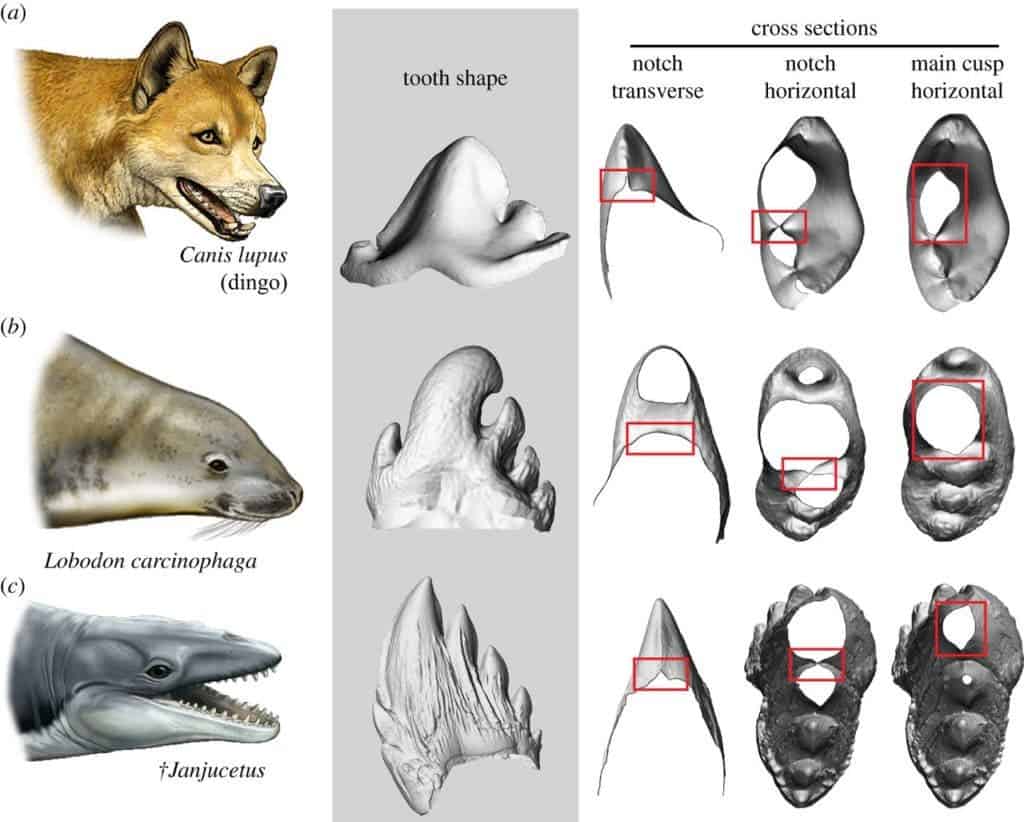Ancient baleen ancestors had teeth as sharp as today’s lions which they used to slice prey to shreds, overturning long-held assumptions about baleen whale evolution. Modern baleen whales use a series of horny filtering combs that line the upper jaw.

At up to 29.9 metres (98 ft) in length and with a maximum recorded weight of 173 tonnes (190 short tons), the blue whale (Balaenoptera musculus) is the largest creature in Earth’s history. That may sound terrifying but this is a gentle giant whose diet consists almost exclusively of krill, a small oceanic creature that generally measures a measly 1-2 centimeters. It does eat copious amounts of it, consuming up to 40 million krill per day or 8,000 pounds simply by plowing the ocean with its bristle-like baleen structures that filter food from the water.
[panel style=”panel-info” title=”Tooth whales don’t include ‘just’ whales” footer=””]Toothed whales make up one of two suborders within the cetacean species.
The term can be misleading since addition to whales the toothed whale suborder also consists of all species of dolphin and porpoise. [/panel]
From hunting to going for volume

“These results are the first to show that ancient baleen whales had extremely sharp teeth with one function—cutting the flesh of their prey,” Museums Victoria’s senior curator of vertebrate palaeontology Erich Fitzgerald said.
“Contrary to what many people thought, whales never used their teeth as a sieve, and instead evolved their signature filter feeding technique later—maybe after their teeth had already been lost.”
The baleen open question
In other words, ancient mysticeti — a term used to describe whales that feed using baleen — had teeth just as sharp and adapted for slicing meat as today’s most successful terrestrial predators and seals. They “never passed through a tooth-based filtration phase, and that the use of teeth and baleen in early whales was not functionally connected,” the authors wrote in the journal Biology Letters.
While the results are quite revealing, they still leave the important question of how baleen filtering appeared in the first place unanswered. One hypothesis suggests baleen filtering co-existed alongside raptorial teeth through a period of overlapping until the baleen strategy eventually won — or at least for some species. Another possibility is that some early mysticeti evolved into suction feeders which came with tooth loss.
More fossils might provide the missing link that bridges the answer to this yet open question. There is already good progress. In May 2017, we reported the discovery of the 36-million-year-old Mystacodon selenensis, which literally means ‘toothed whale’.
Wear on Mystacodon’s teeth tells us that this was a suction feeder who vacuumed up its prey instead of chomping it with its sharp teeth. Suction feeding — possibly an intermediate step toward the filter-feeding strategy we see today in baleen whales — is common among living marine mammals, including seals, dolphins and toothed whales, who use it either to capture prey or to prevent it from floating away while they swallow.


